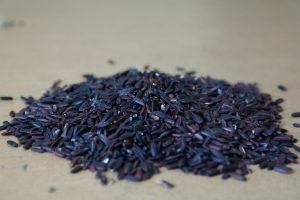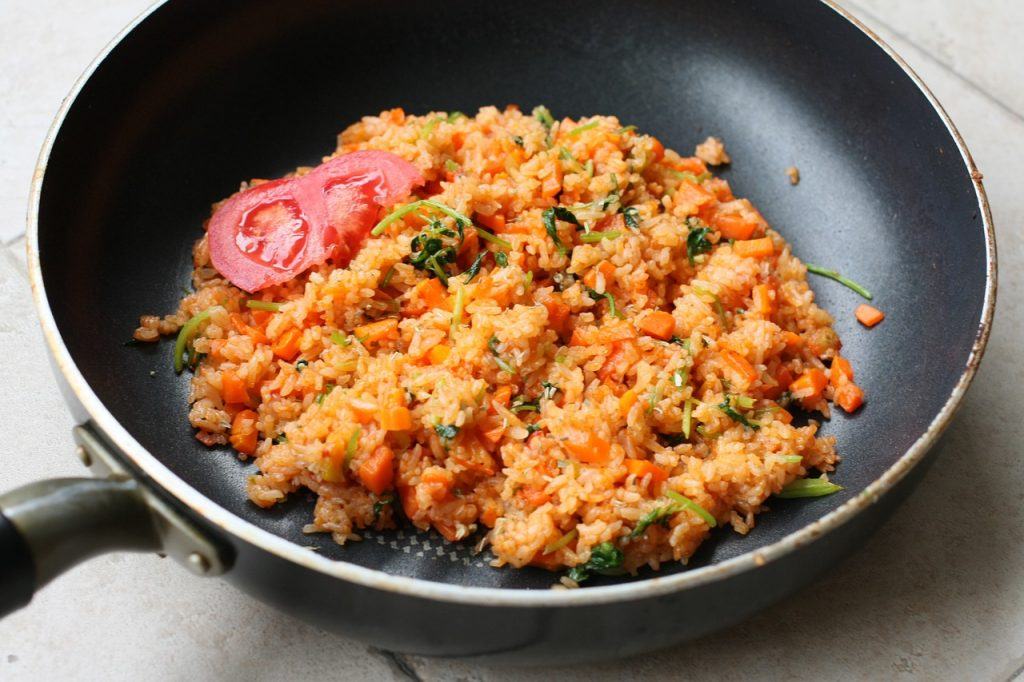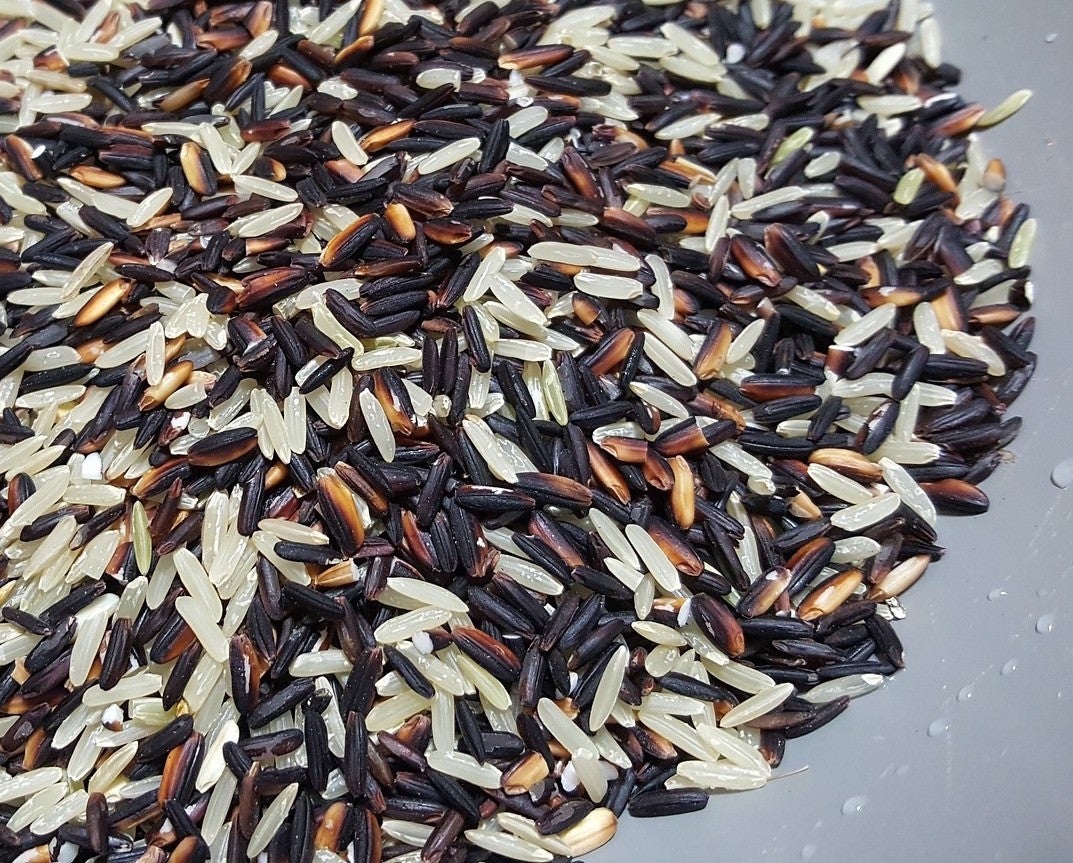Rice is a main staple in more than 100 countries worldwide. [1] In some households, rice is included with more than one meal a day. This starchy high-calorie grain is generally low cost, making it accessible to all and a vital base of many diets. Each country showcases a rice specialty to reflect local spices and taste preferences: risotto in Italy, paella in Spain, jambalaya in the southern U.S., coconut rice in Colombia, steamed rice in China, rice and beans in Mexico, and sweet rice in Portugal, to name a few.
The scientific name for rice is Oryza. Oryza sativa is the most common species and is subdivided into the long-grain indica, and short-grain japonica. Tools for farming rice have been found in China dating back 8000 years. Merchant traders helped the gradual spread of rice across the continents.
Source Of*
(*primarily whole grain varieties)
Types
There are thousands of types of Oryza sativa, which can differ in size, thickness, stickiness, color, aroma, and flavor. Rice is often broadly categorized based on its shape or method of processing:
Long, short, or medium grain
This refers to the length and width of the rice grain after cooking:
- Long grains have a slender kernel over four times as long as they are wide. When cooked, long grain rice stays separate and fluffy (e.g., Jasmine and Basmati rice).
- Medium grains have a shorter, wider kernel, yielding a tender and semi-sticky consistency when cooked (e.g., Arborio rice).
- Short grains have a kernel only twice as long as they are wide, and yield the stickiest texture when cooked (e.g., “sushi” rice).
Whole or refined grain
Is the rice in its whole, intact form (like “brown” rice), or has it been milled and polished (like “white” rice)?
- Whole: Just like all whole grains, rice naturally contains three edible components—the bran, germ, and endosperm (the inedible hull is removed). “Brown” rice is the typical whole grain rice, though this describes not a particular variety but the natural color of the grain. However, whole grain rice is not limited to one color—it also comes in shades of black, purple, and red. Because the fibrous bran layer and nutrient-rich germ remain intact, these varieties typically take longer to cook, and have a nuttier and chewier texture than refined white rice.
- Refined: Rice that is polished to remove the bran layers and embryo so that only the starchy white endosperm remains—hence the name “white” rice (again, this refers to the color and not one particular variety). The milling and polishing process removes the majority of naturally occurring B vitamins, minerals, phytochemicals, and fiber, so B vitamins and iron are added back. Food labels will display the term “enriched” to indicate this. However, only a fraction of the original amount of these nutrients is added back.
Of course, when it comes to cooking, specific varieties of rice are often chosen for their unique characteristics. Here are a few popular types:
- Arborio: A medium-grain rice popular for making risotto and puddings. It undergoes less milling than long-grain rice so it retains more starch, which is released during cooking to produce a naturally creamy consistency without becoming mushy. Unlike other rice cooking methods, water must be added to Arborio rice gradually in segments, with constant stirring, to produce the creamy texture of risotto. Arborio rice is available in both brown and white versions.
- Basmati, Jasmine: These are varieties of long-grain rice with fragrant aromas that are available in both brown and white versions.
 Black (Forbidden), Purple, or Red: These types of short or medium-grain colorful rice contain a natural plant phytochemical called anthocyanins, a flavonoid with antioxidant properties that is also found in blueberries and blackberries. Their nutritious bran and germ layers are intact similar to brown rice.
Black (Forbidden), Purple, or Red: These types of short or medium-grain colorful rice contain a natural plant phytochemical called anthocyanins, a flavonoid with antioxidant properties that is also found in blueberries and blackberries. Their nutritious bran and germ layers are intact similar to brown rice.- Glutinous: Named for its glue-like consistency (not for gluten, which it does not contain), this short-grain rice is especially sticky when cooked. This is because it contains primarily one component of starch, called amylopectin, while other types of rice contain both amylopectin and amylose. Glutinous rice is particularly popular throughout Asia, and is available in a range of colors including white, brown, and black/purple.
Rice and Health
Diabetes
Because large amounts of rice are eaten in some countries, along with an increasing worldwide prevalence of type 2 diabetes and insulin resistance, rice intake’s effect on health has been studied.
The glycemic index (GI) is a measure of how quickly and how much a food raises one’s blood sugar levels after eating. Rice is considered a high GI food but it varies depending on the type and amount of processing (processing increases the GI). Reports show the GI of rice ranging from 48-93. [2] Low GI foods have a rating of 55 or less, medium GI foods are 56-69, and high GI foods are 70-100. The average GI for brown rice is low at 55, whereas the GI for white rice is higher at 64. [3] Observational studies have found an association between a high GI diet and greater risk for type 2 diabetes.
- A meta-analysis of seven large cohort studies in Asian and Western populations found a 55% increased risk of developing type 2 diabetes when comparing the highest to lowest intakes of white rice in Asians. This same study also found a minor increased risk in Western populations, although the finding was not significant, potentially a result of their lower overall rice intake. [4] Another meta-analysis of 16 international cohort studies evaluating whole grain and refined grain intake found a 32% risk reduction in type 2 diabetes risk with a high whole grain intake including brown rice (3 servings daily), while white rice was associated with an increased risk of diabetes in some studies but not all. [5]
- In another study observing three large prospective cohorts in the U.S. of 39,765 men and 157,463 women, it was found that those who ate five or more servings of white rice weekly compared with those eating less than one serving a month had a 17% increased risk of developing type 2 diabetes. In contrast, the highest intakes of brown rice of two or more servings weekly compared with the lowest intake of less than one serving a month was associated with an 11% reduced risk of type 2 diabetes. [3]
The message of these studies was consistent with public health recommendations to replace refined grains with whole grains, and to choose at least two servings of whole grains a day to reduce type 2 diabetes risk.
Cardiovascular health
In a large cohort study of 71,750 women from the Nurses’ Health Study and 42,823 men from the Health Professionals Follow-up Study, intakes of brown rice did not lower the risk of ischemic stroke. [6] However, intakes of brown rice in this group were generally lower than intakes of other grain foods that did decrease stroke risk like whole grain cereals and bran. A systematic review of 45 studies on whole grains did not find a reduced risk of stroke, heart disease, or cancer from intakes of either white or brown rice. [7]
Should I be concerned about arsenic in rice?
Arsenic is a naturally occurring heavy metal found in soil, rock, and water. The term “total arsenic” includes organic and inorganic arsenic compounds. Organic arsenic is found mostly in seafood and is considered less toxic. Inorganic arsenic is toxic and found in soil, groundwater, and industrial chemicals. Though a high amount of inorganic arsenic is deadly, long-term exposure to lower levels is also concerning as it may increase the risk of various diseases.
In 2012, reports surfaced about the potentially high levels of inorganic arsenic in rice. [8] The amount in our food supply results largely from contaminated groundwater and soil from livestock manure, fertilizer, pesticides, and industrial waste. [9] This is concerning to individuals who eat rice daily. Epidemiological studies have shown that long-term exposure to arsenic can lead to high blood pressure, diabetes, and respiratory diseases. Exposure to arsenic at young ages has been linked to certain cancers and neurological defects. [1]
Arsenic accumulates in rice 10 times more than in other grains due to being cultivated in water-flooded fields, where irrigation water as well as the soil may be contaminated with arsenic. [10] The rice grain easily absorbs arsenic into its roots through water. In the U.S., rice grown in southern states contains high amounts of arsenic because of residual metals in the soil from the historical use of arsenic-laced pesticides to treat cotton crops. Rice products such as rice cereal and rice crackers may also contain high levels of arsenic. The amount of arsenic in other types of rice such as black or red depends on the exact species and the amount of inorganic arsenic in the soil and water supply, which can vary greatly by region.
There is no federal limit for arsenic in food and beverages other than water. The standard for drinking water is 10 parts per billion (ppb). One report found as much as 193 ppm in brown rice grown in the southern U.S. [2] A later report by the FDA also found high levels with an average concentration of 154 ppb in brown rice. [11]
Early life exposure to arsenic increases the risk of negative health effects later in life. Non-profit organizations have pushed for federal standards limiting the amount of arsenic in the food supply. Congress introduced a bill in 2012 called the RICE Act (Reducing food-based Inorganic and Organic Compounds Exposure Act) to establish limits on the amount of total arsenic allowed in rice and rice products. [12] In 2016, the Food and Drug Administration (FDA) drafted a proposed limit of 100 ppb in infant rice cereal and juice, but further action by the FDA or voluntary standards by manufacturers have not been established. [13] The FDA advised that parents give infants a variety of fortified cereals other than rice such as oat, barley, and multigrain. Pregnant women and toddlers should also eat a variety of whole grains other than rice. [14]
Additional ways to reduce arsenic exposure from rice:
- Brown rice contains higher levels of arsenic than white rice because the metal accumulates in outer layers of the grain. However, it is not recommended to choose white rice as a staple due to its lesser health benefits. If eating brown rice, wash the rice well, cook in extra water (example: 6-10 cups of water per 1 cup rice as suggested by the FDA), drain the excess water after the grain is cooked, and then rinse one more time. This removes about 50% of arsenic, but keep in mind that some water-soluble B vitamins will also be lost.
- Try other whole grains lower in arsenic like amaranth, bulgur, wheat berries, millet, and quinoa.
If you eat brown rice or brown rice products frequently or more than four times a week, consider purchasing brands grown in non-polluted regions (such as California as opposed to Arkansas or Texas).
Prepare
- Before cooking, rinse rice in cool water until it runs clear to remove excess starch. If rice is obtained from bulk bins, rinsing also helps to remove dust or any unwanted material. It may then be soaked to reduce cooking time and stickiness. Keep in mind that excess washing and rinsing may remove some water-soluble B vitamins, especially for polished enriched white rice, in which the vitamins have been sprayed onto the surface of the grain.
- Rice is typically boiled in water or steamed, as it absorbs water and softens during the cooking process. Long-grain varieties tend to produce fluffy separated grains after cooking, while short or medium grains become sticky.
Make
- Follow package directions as different varieties of rice require differing amounts of water and cook times. In general, use a 2:1 ratio for cooking rice, or 2 cups of water per 1 cup of rice. Bring water to a boil in a saucepan. Add rice and stir into water. Place a lid on the pot and reduce heat to low-medium. Simmer for about 20 minutes for white rice, and 40-45 minutes for brown rice and other minimally processed varieties. Remove from heat and allow to steam in the covered pot for 5-10 minutes. Fluff rice with a fork to separate the grains.
- For extra flavor, use chicken or vegetable broth instead of water while cooking, or add spices into the cooking water. If using fresh chopped herbs, such as chopped parsley, dill, or chives, gently stir them into cooked rice after it is removed from the heat but still steaming in the pot.
- Easy ways to use cooked rice or leftover rice:
- Sauté chopped vegetables and cooked meat or tofu in a pan, then add cooked rice and stir mixture well.
- Add bulk to soup by throwing in a cup of cooked rice.
- Add a handful of cooked rice to a salad.
- For an easy vegan rice bowl, mix together one cup of cooked rice, ½ cup cooked beans, ½ cup salsa, and a handful of greens.

More recipes featuring rice:
Did You Know?
- There are over 40,000 varieties of rice worldwide!
- Wild rice is not in the same rice family as Oryza sativa. It is actually a seed from a grassy aquatic plant. It is high in fiber and minerals and contains slightly more protein than brown rice. It possesses such an intense nutty flavor that is often mixed with milder tasting grains.
References
- Liu K, Zheng J, Chen F. Effects of washing, soaking and domestic cooking on cadmium, arsenic and lead bioaccessibilities in rice. Journal of the Science of Food and Agriculture. 2018 Jan 24.
- Boers HM, ten Hoorn JS, Mela DJ. A systematic review of the influence of rice characteristics and processing methods on postprandial glycaemic and insulinaemic responses. British Journal of Nutrition. 2015 Oct;114(7):1035-45.
- Sun Q, Spiegelman D, van Dam RM, Holmes MD, Malik VS, Willett WC, Hu FB. White rice, brown rice, and risk of type 2 diabetes in US men and women. Archives of internal medicine. 2010 Jun 14;170(11):961-9.
- Hu EA, Pan A, Malik V, Sun Q. White rice consumption and risk of type 2 diabetes: meta-analysis and systematic review. Bmj. 2012 Mar 15;344:e1454.
- Aune D, Norat T, Romundstad P, Vatten LJ. Whole grain and refined grain consumption and the risk of type 2 diabetes: a systematic review and dose–response meta-analysis of cohort studies. European journal of epidemiology. 2013 Nov 1;28(11):845-58.
- Juan J, Liu G, Willett WC, Hu FB, Rexrode KM, Sun Q. Whole Grain Consumption and Risk of Ischemic Stroke: Results From 2 Prospective Cohort Studies. Stroke. 2017 Dec;48(12):3203-9.
- Aune D, Keum N, Giovannucci E, Fadnes LT, Boffetta P, Greenwood DC, Tonstad S, Vatten LJ, Riboli E, Norat T. Whole grain consumption and risk of cardiovascular disease, cancer, and all cause and cause specific mortality: systematic review and dose-response meta-analysis of prospective studies. Bmj. 2016 Jun 14;353:i2716.
- Consumer Reports. Arsenic in your food. November 2012. https://consumerreports.org/cro/magazine/2012/11/arsenic-in-your-food/index.htm. Accessed 7/16/18.
- Nachman KE, Ginsberg GL, Miller MD, Murray CJ, Nigra AE, Pendergrast CB. Mitigating dietary arsenic exposure: Current status in the United States and recommendations for an improved path forward. Science of the Total Environment. 2017 Mar 1;581:221-36.
- Davis MA, Signes-Pastor AJ, Argos M, Slaughter F, Pendergrast C, Punshon T, Gossai A, Ahsan H, Karagas MR. Assessment of human dietary exposure to arsenic through rice. Science of The Total Environment. 2017 May 15;586:1237-44.
- U.S. Food and Drug Administration. Arsenic in Rice and Rice Products Risk Assessment Report. 2016. http://www.fda.gov/Food/FoodScienceResearch/RiskSafetyAssessment/default.htm. Accessed 7/16/18.
- RICE Act (Reducing food-based Inorganic and Organic Compounds Exposure Act of 2012), H.R.6509, 112th Congress (2011-2012).
- U.S. Food and Drug Administration. Inorganic Arsenic in Rice Cereals for Infants: Action Level; Draft Guidance for Industry. Federal Register. 81 FR 19976: 19976-19978. https://federalregister.gov/documents/2016/04/06/2016-07840/inorganic-arsenic-in-rice-cereals-for-infants-action-level-draft-guidance-for-industry-supporting. Accessed 7/16/18.
- U.S. Food and Drug Administration. FDA proposes limit for inorganic arsenic in infant rice cereal. April 6, 2016. https://fda.gov/NewsEvents/Newsroom/PressAnnouncements/ucm493740.htm. Accessed 7/16/18.
Terms of Use
The contents of this website are for educational purposes and are not intended to offer personal medical advice. You should seek the advice of your physician or other qualified health provider with any questions you may have regarding a medical condition. Never disregard professional medical advice or delay in seeking it because of something you have read on this website. The Nutrition Source does not recommend or endorse any products.
 Black (Forbidden), Purple, or Red: These types of short or medium-grain colorful rice contain a natural plant phytochemical called anthocyanins, a flavonoid with antioxidant properties that is also found in blueberries and blackberries. Their nutritious bran and germ layers are intact similar to brown rice.
Black (Forbidden), Purple, or Red: These types of short or medium-grain colorful rice contain a natural plant phytochemical called anthocyanins, a flavonoid with antioxidant properties that is also found in blueberries and blackberries. Their nutritious bran and germ layers are intact similar to brown rice.
